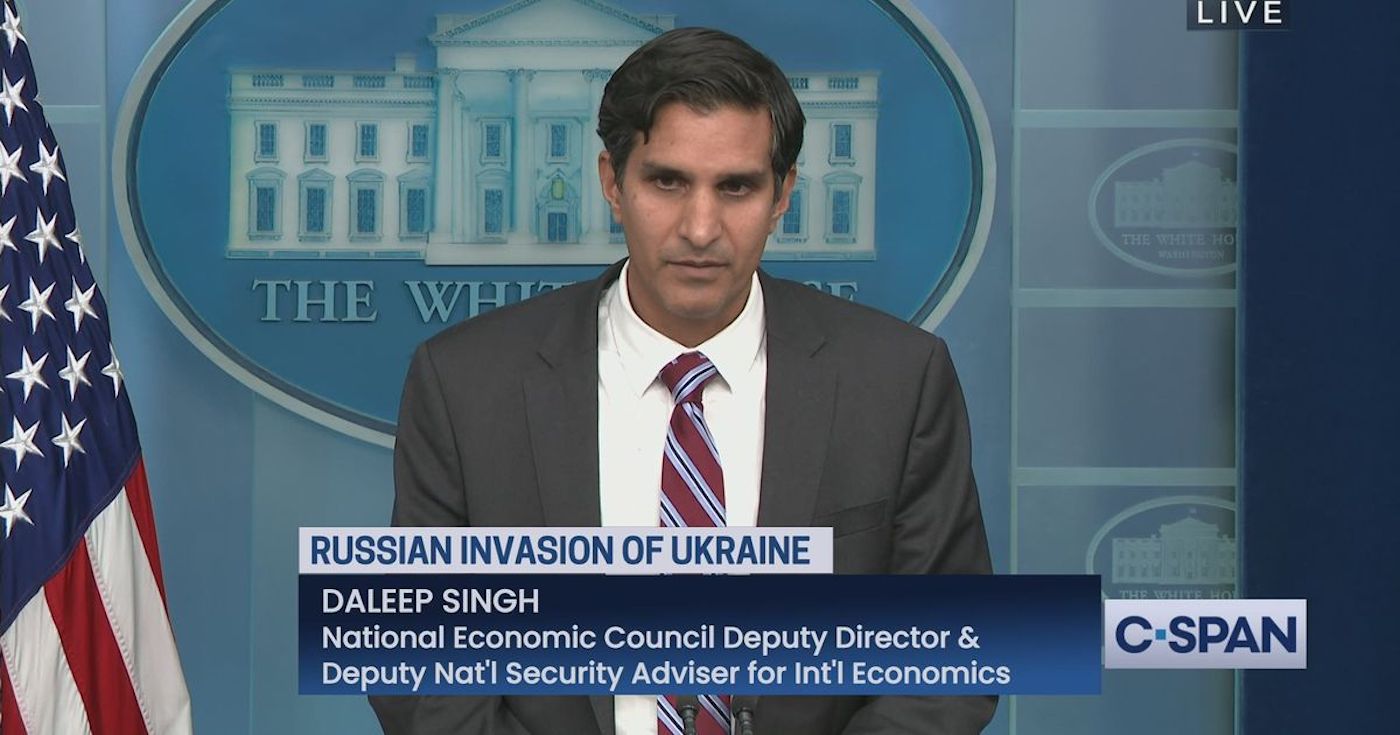Unlawful Entry in Front Yard of Deputy National Security Advisor Daleep Singh’s D.C. Home Investigated by Police
- However, investigators couldn't establish a link between his work as President Biden’s point man in charge of sanctions on Russia and the Feb. 26 incident.

Last month, President Biden’s deputy national security advisor Daleep Singh’s house in “an upscale Northwest Washington neighborhood about five miles from the White House,” was the target of an “unlawful entry,” The Washington Post reported today. The D.C. police were investigating the incident, The Post said, where a man was seen on the front yard of Singh’s property. ”
Singh was not a widely known White House official. But since the Russian invasion of Ukraine began, the Indian American has quickly become the public face of the administration’s sanctions against Moscow. He has been seen at the White House press briefings and his meetings and discussions with the president have been widely reported in the media.
Citing a D.C. police department public incident report, The Post said the man who was seen about 1 p.m. on Feb. 26 “then fled the scene in a ‘blue/teal’ older model BMW sedan.” The report didn’t offer any details of whether the man entered the house. However, Singh told the police that the man “unlawfully entered the front yard” of his property and that he did not know the man, The Post report said.
While there has been no immediate evidence of a link between Singh’s work in the administration and the alleged incident, some officials have raised concerns internally about the incident, particularly given that it took place so soon after Singh became such a prominent figure in the rollout of U.S. sanctions, the Post said, quoting a government official familiar with internal deliberations. “The White House declined to comment, as did a spokesperson for the Secret Service, which has participated in the investigation,” the Post report said.
Meanwhile, two of Sing’s neighbors told The Post that a short time later, officers on the scene told a neighbor that they were “investigating a potential break-in.” They also told the paper that “some who live in nearby homes were later approached by Secret Service agents seeking security camera footage.” However, “the investigation was temporarily suspended for lack of any leads on likely suspects,” The Post said.
Singh has made several media appearances to talk about sanctions since his first appearance at the White House press podium was last month. On his second appearance on Feb. 22, he joined press secretary Jen Psaki for the daily press briefing. “Back by popular demand,” Psaki said while introducing Singh. “If he decides he’s not going to be an economics expert anymore, he might have a future in our business.”
In his opening remarks, Singh said that “Russia’s long previewed invasion of Ukraine has begun and so too has our response.” Noting the press the “speed and coordination” in President Biden’s response was “historic,” Singh said unlike “previous sanctions regimes, we announced our first tranche of sanctions in less than a day and in lockstep with Allies and partners in the European Union, the United Kingdom, Canada, Japan, and Australia.”
At the Feb. 24 press briefing, Singh reviewed an “unprecedented” package of sanctions “that will ‘isolate Russia from the global financial system.” He told reporters that the Biden administration expects the costs of new sanctions on Russia will build over time and won’t disrupt global energy flows.“Singh has also become a key author of the White House’s rolling sanctions scheme, which was designed to serve as both a deterrent and now a punishment for Putin’s actions in Ukraine,” Politico says in its West Wing Playbook.
The 47-year-old was also deputy assistant secretary of the Treasury for international affairs and acting Assistant Secretary of the Treasury for Financial Markets in the Obama administration. In 2014, while working in the Obama administration, Singh was involved in implementing sanctions on Russia, following its annexation of Ukraine’s Crimean peninsula. He worked at the U.S. Department of the Treasury as Acting Assistant Secretary for Financial Markets and Deputy Assistant Secretary for International Affairs. In that role, he helped shape the Treasury Department’s crisis response to Ukraine, Russia, Greece, and Puerto Rico. He also directed the Treasury Department’s Markets Room, which provided real-time and thematic analysis for senior officials.
In a September 12, 2018, Senate Banking Committee hearing on Capitol Hill, Singh shared his experiences. As a Treasury official who “worked extensively on the design of Russia sanctions in 2014,” Singh said he drew three main conclusions from the experience. “Sanctions do their job,” he said, “if they are carefully designed and embedded into a coherent foreign policy.” He continued: “The signaling of future sanctions is at least as potent as the actions themselves,” adding that “sanctions aren’t enough to change behavior.” He also outlined how the U.S. could implement a broader sanctions campaign against Russia in the future. “Sanctions against a country like Russia,” he said, “should demonstrate U.S. resolve and capacity to impose overwhelming costs; limit contagion through the U.S. and global financial system; avoid the appearance of punishing the Russian civilian population; increase the chance of partnering with international allies, and preserve the scope for escalation or de-escalation.”
Singh is the great grand-nephew of Daleep Singh Saund, the first Asian-American elected to the U.S. Congress.


